Electrochemical (Bio)Sensors Based on Covalent Organic Frameworks (COFs)
Abstract
:1. Introduction
2. Electrochemical Sensors
2.1. COFs Acting as Electrocatalysts
2.1.1. COFs Combined with Carbon Materials
2.1.2. COFs Combined with Conducting Polymers
2.1.3. COFs Combined with Metal Oxide Particles
2.1.4. CODs with Electroactive Moieties
2.2. COFs Acting as Support of Electrocatalyst and/or Recognition Elements
2.2.1. COFs with Metal Nanoparticles and/or Carbon Materials
2.2.2. COFs with Metal Oxide Nanomaterials
2.2.3. COFs with 2D-Nanomaterials
2.2.4. COFs with Porphyrins Derivatives
2.2.5. COFs with Macrocycles
2.2.6. COFs with Molecular Imprinted Polymers
2.2.7. COF Templates
2.3. COFs Chelating Properties for Anodic Stripping Analysis
3. Electrochemical Biosensors
3.1. Enzymatic Biosensors
3.2. Immunosensors
3.3. Genosensors
3.4. Aptasensors
4. Conclusions
Author Contributions
Funding
Institutional Review Board Statement
Informed Consent Statement
Data Availability Statement
Conflicts of Interest
References
- Geng, K.; He, T.; Liu, R.; Dalapati, S.; Tan, K.T.; Li, Z.; Tao, S.; Gong, Y.; Jiang, Q.; Jiang, D. Covalent Organic Frameworks: Design, Synthesis, and Functions. Chem. Rev. 2020, 120, 8814–8933. [Google Scholar] [CrossRef] [PubMed]
- Hu, J.; Gupta, S.K.; Ozdemir, J.; Beyzavi, H. Applications of Dynamic Covalent Chemistry Concept toward Tailored Covalent Organic Framework Nanomaterials: A Review. ACS Appl. Nano Mater. 2020, 3, 6239–6269. [Google Scholar] [CrossRef] [PubMed]
- Zhang, K.; Kirlikovali, K.O.; Varma, R.S.; Jin, Z.; Jang, H.W.; Farha, O.K.; Shokouhimehr, M. Covalent Organic Frameworks: Emerging Organic Solid Materials for Energy and Electrochemical Applications. ACS Appl. Mater. Interfaces 2020, 12, 27821–27852. [Google Scholar] [CrossRef]
- Lohse, M.S.; Bein, T. Covalent Organic Frameworks: Structures, Synthesis, and Applications. Adv. Funct. Mater. 2018, 28, 1705553. [Google Scholar] [CrossRef] [Green Version]
- Segura, J.L.; Royuela, S.; Ramos, M.M. Post-synthetic modification of covalent organic frameworks. Chem. Soc. Rev. 2019, 48, 3903–3945. [Google Scholar] [CrossRef] [PubMed]
- Zhao, F.; Liu, H.; Mathe, S.D.R.; Dong, A.; Zhang, J. Covalent Organic Frameworks: From Materials Design to Biomedical Application. Nanomaterials 2017, 8, 15. [Google Scholar] [CrossRef] [Green Version]
- Li, X.; Yang, C.; Sun, B.; Cai, S.; Chen, Z.; Lv, Y.; Zhang, J.; Liu, Y. Expeditious synthesis of covalent organic frameworks: A review. J. Mater. Chem. A 2020, 8, 16045–16060. [Google Scholar] [CrossRef]
- Bourda, L.; Krishnaraj, C.; Van Der Voort, P.; Van Hecke, K. Conquering the crystallinity conundrum: Efforts to increase quality of covalent organic frameworks. Mater. Adv. 2021, 2, 2811–2845. [Google Scholar] [CrossRef]
- Diercks, C.S.; Yaghi, O.M. The atom, the molecule, and the covalent organic framework. Science 2017, 355, eaal1585. [Google Scholar] [CrossRef]
- Martínez-Fernández, M.; Gavara, R.; Royuela, S.; Fernández-Ecija, L.; Martínez, J.I.; Zamora, F.; Segura, J.L. Following the light: 3D-printed COF@poly(2-hydroxyethyl methacrylate) dual emissive composite with response to polarity and acidity. J. Mater. Chem. A 2022, 10, 4634–4643. [Google Scholar] [CrossRef]
- Martínez-Fernández, M.; Martínez-Periñán, E.; Royuela, S.; Martínez, J.I.; Zamora, F.; Lorenzo, E.; Segura, J.L. Covalent organic frameworks based on electroactive naphthalenediimide as active electrocatalysts toward oxygen reduction reaction. Appl. Mater. Today 2022, 26, 101384. [Google Scholar] [CrossRef]
- Tian, Y.; Xu, S.-Q.; Liang, R.-R.; Qian, C.; Jiang, G.-F.; Zhao, X. Construction of two heteropore covalent organic frameworks with Kagome lattices. Cryst. Eng. Comm. 2017, 19, 4877–4881. [Google Scholar] [CrossRef]
- Abuzeid, H.R.; El-Mahdy, A.F.M.; Kuo, S.-W. Hydrogen bonding induces dual porous types with microporous and mesoporous covalent organic frameworks based on bicarbazole units. Micropor. Mesopor. Mat. 2020, 300, 110151. [Google Scholar] [CrossRef]
- Xing, G.; Zheng, W.; Gao, L.; Zhang, T.; Wu, X.; Fu, S.; Song, X.; Zhao, Z.; Osella, S.; Martínez-Abadía, M.; et al. Nonplanar Rhombus and Kagome 2D Covalent Organic Frameworks from Distorted Aromatics for Electrical Conduction. J. Am. Chem. Soc. 2022, 144, 5042–5050. [Google Scholar] [CrossRef]
- Spitler, E.L.; Colson, J.W.; Uribe-Romo, F.J.; Woll, A.R.; Giovino, M.R.; Saldivar, A.; Dichtel, W.R. Lattice Expansion of Highly Oriented 2D Phthalocyanine Covalent Organic Framework Films. Angew. Chem. Int. Ed. 2012, 51, 2623–2627. [Google Scholar] [CrossRef]
- Royuela, S.; Almarza, J.; Mancheño, M.J.; Flores, J.C.P.; Michel, E.G.; Ramos, M.M.; Zamora, F.; Ocón, P.; Segura, J.L. Synergistic Effect of Covalent Bonding and Physical Encapsulation of Sulfur in the Pores of a Microporous COF to Improve Cycling Performance in Li-S Batteries. Chem. A Eur. J. 2019, 25, 12394–12404. [Google Scholar] [CrossRef] [Green Version]
- Fang, Q.; Wang, J.; Gu, S.; Kaspar, R.B.; Zhuang, Z.; Zheng, J.; Guo, H.; Qiu, S.; Yan, Y. 3D Porous Crystalline Polyimide Covalent Organic Frameworks for Drug Delivery. J. Am. Chem. Soc. 2015, 137, 8352–8355. [Google Scholar] [CrossRef]
- Zhang, Y.-B.; Su, J.; Furukawa, H.; Yun, Y.; Gándara, F.; Duong, A.; Zou, X.; Yaghi, O.M. Single-Crystal Structure of a Covalent Organic Framework. J. Am. Chem. Soc. 2013, 135, 16336–16339. [Google Scholar] [CrossRef]
- Wang, X.; Bahri, M.; Fu, Z.; Little, M.A.; Liu, L.; Niu, H.; Browning, N.D.; Chong, S.Y.; Chen, L.; Ward, J.W.; et al. A Cubic 3D Covalent Organic Framework with nbo Topology. J. Am. Chem. Soc. 2021, 143, 15011–15016. [Google Scholar] [CrossRef]
- Gui, B.; Liu, X.; Cheng, Y.; Zhang, Y.; Chen, P.; He, M.; Sun, J.; Wang, C. Tailoring the Pore Surface of 3D Covalent Organic Frameworks via Post-Synthetic Click Chemistry. Angew. Chem. Int. Ed. 2021, 61, e202113852. [Google Scholar] [CrossRef]
- Rowan, S.J.; Cantrill, S.J.; Cousins, G.R.L.; Sanders, J.K.M.; Stoddart, J.F. Dynamic Covalent Chemistry. Angew. Chem. Int. Ed. 2002, 41, 898–952. [Google Scholar] [CrossRef]
- Jin, Y.; Yu, C.; Denman, R.J.; Zhang, W. Recent advances in dynamic covalent chemistry. Chem. Soc. Rev. 2013, 42, 6634–6654. [Google Scholar] [CrossRef] [PubMed]
- Smith, B.J.; Dichtel, W.R. Mechanistic Studies of Two-Dimensional Covalent Organic Frameworks Rapidly Polymerized from Initially Homogenous Conditions. J. Am. Chem. Soc. 2014, 136, 8783–8789. [Google Scholar] [CrossRef] [PubMed]
- Chen, D.; Chen, W.; Xing, G.; Zhang, T.; Chen, L. An Upgraded “Two-in-One” Strategy toward Highly Crystalline Covalent Organic Frameworks Chem. Eur. J. 2020, 26, 8377. [Google Scholar] [CrossRef] [PubMed]
- Fischbach, D.M.; Rhoades, G.; Espy, C.; Goldberg, F.; Smith, B.J. Controlling the crystalline structure of imine-linked 3D covalent organic frameworks. Chem. Commun. 2019, 55, 3594–3597. [Google Scholar] [CrossRef] [Green Version]
- Li, R.L.; Flanders, N.C.; Evans, A.M.; Ji, W.; Castano, I.; Chen, L.X.; Gianneschi, N.C.; Dichtel, W.R. Controlled growth of imine-linked two-dimensional covalent organic framework nanoparticles. Chem. Sci. 2019, 10, 3796–3801. [Google Scholar] [CrossRef] [Green Version]
- Ritchie, L.K.; Trewin, A.; Reguera-Galan, A.; Hasell, T.; Cooper, A.I. Synthesis of COF-5 using microwave irradiation and conventional solvothermal routes. Microporous Mesoporous Mater. 2010, 132, 132–136. [Google Scholar] [CrossRef]
- Maschita, J.; Banerjee, T.; Savasci, G.; Haase, F.; Ochsenfeld, C.; Lotsch, B.V. Ionothermal Synthesis of Imide-Linked Covalent Organic Frameworks. Angew. Chem. Int. Ed. 2020, 59, 15750–15758. [Google Scholar] [CrossRef]
- Liu, K.; Qi, H.; Dong, R.; Shivhare, R.; Addicoat, M.; Zhang, T.; Sahabudeen, H.; Heine, T.; Mannsfeld, S.; Kaiser, U.; et al. On-water surface synthesis of crystalline, few-layer two-dimensional polymers assisted by surfactant monolayers. Nat. Chem. 2019, 11, 994–1000. [Google Scholar] [CrossRef]
- Yang, L.; Guo, Q.; Kang, H.; Chen, R.; Liu, Y.; Wei, D. Self-Controlled Growth of Covalent Organic Frameworks by Repolymerization. Chem. Mater. 2020, 32, 5634–5640. [Google Scholar] [CrossRef]
- Liu, X.-H.; Guan, C.-Z.; Ding, S.-Y.; Wang, W.; Yan, H.-J.; Wang, D.; Wan, L.-J. On-Surface Synthesis of Single-Layered Two-Dimensional Covalent Organic Frameworks via Solid–Vapor Interface Reactions. J. Am. Chem. Soc. 2013, 135, 10470–10474. [Google Scholar] [CrossRef] [PubMed]
- Zhao, Y.; Guo, L.; Gándara, F.; Ma, Y.; Liu, Z.; Zhu, C.; Lyu, H.; Trickett, C.A.; Kapustin, E.A.; Terasaki, O.; et al. A Synthetic Route for Crystals of Woven Structures, Uniform Nanocrystals, and Thin Films of Imine Covalent Organic Frameworks. J. Am. Chem. Soc. 2017, 139, 13166–13172. [Google Scholar] [CrossRef] [PubMed]
- Priya, P.; Nguyen, T.C.; Saxena, A.; Aluru, N.R. Machine Learning Assisted Screening of Two-Dimensional Materials for Water Desalination. ACS Nano 2022, 16, 1929–1939. [Google Scholar] [CrossRef] [PubMed]
- Yang, P.; Zhang, H.; Lai, X.; Wang, K.; Yang, Q.; Yu, D. Accelerating the Selection of Covalent Organic Frameworks with Automated Machine Learning. ACS Omega 2021, 6, 17149–17161. [Google Scholar] [CrossRef] [PubMed]
- Maschita, J.; Banerjee, T.; Lotsch, B.V. Direct and Linker-Exchange Alcohol-Assisted Hydrothermal Synthesis of Imide-Linked Covalent Organic Frameworks. Chem. Mater. 2022, 34, 2249–2258. [Google Scholar] [CrossRef]
- Sick, T.; Rotter, J.M.; Reuter, S.; Kandambeth, S.; Bach, N.N.; Döblinger, M.; Merz, J.; Clark, T.; Marder, T.B.; Bein, T.; et al. Switching on and off Interlayer Correlations and Porosity in 2D Covalent Organic Frameworks. J. Am. Chem. Soc. 2019, 141, 12570–12581. [Google Scholar] [CrossRef]
- Uribe-Romo, F.J.; Hunt, J.R.; Furukawa, H.; Klöck, C.; O’Keeffe, M.; Yaghi, O.M. A Crystalline Imine-Linked 3-D Porous Covalent Organic Framework. J. Am. Chem. Soc. 2009, 131, 4570–4571. [Google Scholar] [CrossRef]
- García-Arroyo, P.; Martínez-Periñán, E.; Cabrera-Trujillo, J.J.; Salagre, E.; Michel, E.G.; Martínez, J.I.; Lorenzo, E.; Segura, J.L. Pyrenetetraone-based covalent organic framework as an effective electrocatalyst for oxygen reduction reaction. Nano Res. 2022, 15, 3907–3912. [Google Scholar] [CrossRef]
- Alonso-Navarro, M.J.; Barrio, J.; Royuela, S.; Karjule, N.; Ramos, M.M.; Martínez, J.I.; Shalom, M.; Segura, J.L. Photocatalytic degradation of organic pollutants through conjugated poly(azomethine) networks based on terthiophene–naphthalimide assemblies. RSC Adv. 2021, 11, 2701–2705. [Google Scholar] [CrossRef]
- Xu, H.; Gao, J.; Jiang, D. Stable, crystalline, porous, covalent organic frameworks as a platform for chiral organocatalysts. Nat. Chem. 2015, 7, 905–912. [Google Scholar] [CrossRef]
- Wu, C.; Liu, Y.; Liu, H.; Duan, C.; Pan, Q.; Zhu, J.; Hu, F.; Ma, X.; Jiu, T.; Li, Z.; et al. Highly Conjugated Three-Dimensional Covalent Organic Frameworks Based on Spirobifluorene for Perovskite Solar Cell Enhancement. J. Am. Chem. Soc. 2018, 140, 10016–10024. [Google Scholar] [CrossRef] [PubMed]
- van der Jagt, R.; Vasileiadis, A.; Veldhuizen, H.; Shao, P.; Feng, X.; Ganapathy, S.; Habisreutinger, N.C.; van der Veen, M.A.; Wang, C.; Wagemaker, M.; et al. Synthesis and Structure–Property Relationships of Polyimide Covalent Organic Frameworks for Carbon Dioxide Capture and (Aqueous) Sodium-Ion Batteries. Chem. Mater. 2021, 33, 818–833. [Google Scholar] [CrossRef] [PubMed]
- Huo, J.; Luo, B.; Chen, Y. Crystalline Covalent Organic Frameworks from Triazine Nodes as Porous Adsorbents for Dye Pollutants. ACS Omega 2019, 4, 22504–22513. [Google Scholar] [CrossRef] [Green Version]
- Kato, M.; Ota, R.; Endo, T.; Yanase, T.; Nagahama, T.; Shimada, T. Free-Standing Nanometer-Thick Covalent Organic Framework Films for Separating CO2 and N2. ACS Appl. Nano Mater. 2022, 5, 2367–2374. [Google Scholar] [CrossRef]
- Jiang, L.; Tian, Y.; Sun, T.; Zhu, Y.; Ren, H.; Zou, X.; Ma, Y.; Meihaus, K.R.; Long, J.R.; Zhu, G. A Crystalline Polyimide Porous Organic Framework for Selective Adsorption of Acetylene over Ethylene. J. Am. Chem. Soc. 2018, 140, 15724–15730. [Google Scholar] [CrossRef]
- Royuela, S.; Millán, R.G.-S.; Mancheño, M.J.; Ramos, M.M.; Segura, J.L.; Navarro, J.A.R.; Zamora, F. Catalytically Active Imine-based Covalent Organic Frameworks for Detoxification of Nerve Agent Simulants in Aqueous Media. Materials 2019, 12, 1974. [Google Scholar] [CrossRef] [Green Version]
- Liu, X.; Huang, D.; Lai, C.; Zeng, G.; Qin, L.; Wang, H.; Yi, H.; Li, B.; Liu, S.; Zhang, M.; et al. Recent advances in covalent organic frameworks (COFs) as a smart sensing material. Chem. Soc. Rev. 2019, 48, 5266–5302. [Google Scholar] [CrossRef]
- Rodríguez-San-Miguel, D.; Montoro, C.; Zamora, F. Covalent organic framework nanosheets: Preparation, properties and applications. Chem. Soc. Rev. 2020, 49, 2291–2302. [Google Scholar] [CrossRef]
- Tao, Y.; Ji, W.; Ding, X.; Han, B.-H. Exfoliated covalent organic framework nanosheets. J. Mater. Chem. A 2021, 9, 7336–7365. [Google Scholar] [CrossRef]
- Chandra, S.; Kandambeth, S.; Biswal, B.P.; Lukose, B.; Kunjir, S.M.; Chaudhary, M.; Babarao, R.; Heine, T.; Banerjee, R. Chemically Stable Multilayered Covalent Organic Nanosheets from Covalent Organic Frameworks via Mechanical Delamination. J. Am. Chem. Soc. 2013, 135, 17853–17861. [Google Scholar] [CrossRef]
- Yan, Z.; Fang, L.; He, Z.; Xie, H.; Liu, B.; Guo, B.; Yao, Y. Surfactant-Modulated a Highly Sensitive Fluorescent Probe of Fully Conjugated Covalent Organic Nanosheets for Detecting Copper Ions in Aqueous Solution. Small 2022, 18, 2200388. [Google Scholar] [CrossRef]
- Mow, R.E.; Lipton, A.S.; Shulda, S.; Gaulding, E.A.; Gennett, T.; Braunecker, W.A. Colloidal three-dimensional covalent organic frameworks and their application as porous liquids. J. Mater. Chem. A 2020, 8, 23455–23462. [Google Scholar] [CrossRef]
- Liu, X.; Lim, G.J.; Wang, Y.; Zhang, L.; Mullangi, D.; Wu, Y.; Zhao, D.; Ding, J.; Cheetham, A.K.; Wang, J. Binder-free 3D printing of covalent organic framework (COF) monoliths for CO2 adsorption. Chem. Eng. J. 2020, 403, 126333. [Google Scholar] [CrossRef]
- Zhang, M.; Li, L.; Lin, Q.; Tang, M.; Wu, Y.; Ke, C. Hierarchical-Coassembly-Enabled 3D-Printing of Homogeneous and Heterogeneous Covalent Organic Frameworks. J. Am. Chem. Soc. 2019, 141, 5154–5158. [Google Scholar] [CrossRef]
- Karak, S.; Dey, K.; Torris, A.; Halder, A.; Bera, S.; Kanheerampockil, F.; Banerjee, R. Inducing Disorder in Order: Hierarchically Porous Covalent Organic Framework Nanostructures for Rapid Removal of Persistent Organic Pollutants. J. Am. Chem. Soc. 2019, 141, 7572–7581. [Google Scholar] [CrossRef]
- Martín-Illán, J.; Rodríguez-San-Miguel, D.; Castillo, O.; Beobide, G.; Perez-Carvajal, J.; Imaz, I.; Maspoch, D.; Zamora, F. Macroscopic Ultralight Aerogel Monoliths of Imine-based Covalent Organic Frameworks. Angew. Chem. Int. Ed. 2021, 60, 13969–13977. [Google Scholar] [CrossRef]
- Chen, S.; Yuan, B.; Liu, G.; Zhang, D. Electrochemical Sensors Based on Covalent Organic Frameworks: A Critical Review. Front. Chem. 2020, 8, 601044. [Google Scholar] [CrossRef]
- Tan, X.; Zhang, Z.; Cao, T.; Zeng, W.; Huang, T.; Zhao, G. Control Assembly of Pillar[6]arene-Modified Ag Nanoparticles on Covalent Organic Framework Surface for Enhanced Sensing Performance toward Paraquat. ACS Sustain. Chem. Eng. 2019, 7, 20051–20059. [Google Scholar] [CrossRef]
- Liu, X.; Hu, M.; Wang, M.; Song, Y.; Zhou, N.; He, L.; Zhang, Z. Novel nanoarchitecture of Co-MOF-on-TPN-COF hybrid: Ultralowly sensitive bioplatform of electrochemical aptasensor toward ampicillin. Biosens. Bioelectron. 2018, 123, 59–68. [Google Scholar] [CrossRef]
- Li, H.; Kou, B.; Yuan, Y.; Chai, Y.; Yuan, R. Porous Fe3O4@COF-Immobilized gold nanoparticles with excellent catalytic performance for sensitive electrochemical detection of ATP. Biosens. Bioelectron. 2021, 197, 113758. [Google Scholar] [CrossRef]
- Ma, X.; Pang, C.; Li, S.; Xiong, Y.; Li, J.; Luo, J.; Yang, Y. Synthesis of Zr-coordinated amide porphyrin-based two-dimensional covalent organic framework at liquid-liquid interface for electrochemical sensing of tetracycline. Biosens. Bioelectron. 2019, 146, 111734. [Google Scholar] [CrossRef]
- Bian, G.; Yin, J.; Zhu, J. Recent Advances on Conductive 2D Covalent Organic Frameworks. Small 2021, 17, 2006043. [Google Scholar] [CrossRef]
- Sun, L.; Guo, H.; Pan, Z.; Liu, B.; Zhang, T.; Yang, M.; Wu, N.; Zhang, J.; Yang, F.; Yang, W. In-situ reducing platinum nanoparticles on covalent organic framework as a sensitive electrochemical sensor for simultaneous detection of catechol, hydroquinone and resorcinol. Colloids Surf. A Physicochem. Eng. Asp. 2021, 635, 128114. [Google Scholar] [CrossRef]
- Guan, Q.; Guo, H.; Wu, N.; Cao, Y.; Wang, M.; Zhang, L.; Yang, W. Highly sensitive determination of acetaminophen and 4-aminophenol based on COF/3D NCNF-T/Au NPs composite electrochemical sensing platform. Colloids Surf. A Physicochem. Eng. Asp. 2021, 630, 127624. [Google Scholar] [CrossRef]
- Geng, W.-Y.; Zhang, H.; Luo, Y.-H.; Zhu, X.-G.; Xie, A.-D.; Wang, J.; Zhang, D.-E. Facile fabrication of carbon-loaded covalent-organic framework composites with enhanced electrochemical performance for dopamine determination. Microporous Mesoporous Mater. 2021, 323, 111186. [Google Scholar] [CrossRef]
- Wu, N.; Wang, L.; Xie, Y.; Du, Y.; Song, Y.; Wang, L. Double signal ratiometric electrochemical riboflavin sensor based on macroporous carbon/electroactive thionine-contained covalent organic framework. J. Colloid Interface Sci. 2021, 608, 219–226. [Google Scholar] [CrossRef]
- Yang, Y.; Shen, Y.; Wang, L.; Song, Y.; Wang, L. Three-dimensional porous carbon/covalent-organic framework films integrated electrode for electrochemical sensors. J. Electroanal. Chem. 2019, 855, 113590. [Google Scholar] [CrossRef]
- Liu, Y.; Zhou, M.; Jin, C.; Zeng, J.; Huang, C.; Song, Q.; Song, Y. Preparation of a Sensor Based on Biomass Porous Carbon/Covalent-Organic Frame Composites for Pesticide Residues Detection. Front. Chem. 2020, 8, 643. [Google Scholar] [CrossRef]
- Wang, L.; Xie, Y.; Yang, Y.; Liang, H.; Wang, L.; Song, Y. Electroactive Covalent Organic Frameworks/Carbon Nanotubes Composites for Electrochemical Sensing. ACS Appl. Nano Mater. 2020, 3, 1412–1419. [Google Scholar] [CrossRef]
- Zhang, T.; Gao, C.; Huang, W.; Chen, Y.; Wang, Y.; Wang, J. Covalent organic framework as a novel electrochemical platform for highly sensitive and stable detection of lead. Talanta 2018, 188, 578–583. [Google Scholar] [CrossRef]
- Xin, Y.; Wang, N.; Wang, C.; Gao, W.; Chen, M.; Liu, N.; Duan, J.; Hou, B. Electrochemical detection of hydroquinone and catechol with covalent organic framework modified carbon paste electrode. J. Electroanal. Chem. 2020, 877, 114530. [Google Scholar] [CrossRef]
- Wu, S.; Li, M.; Phan, H.; Wang, D.; Herng, T.S.; Ding, J.; Lu, Z.-G.; Wu, J. Toward Two-Dimensional π-Conjugated Covalent Organic Radical Frameworks. Angew. Chem. Int. Ed. 2018, 57, 8007–8011. [Google Scholar] [CrossRef] [PubMed]
- Evans, A.M.; Parent, L.R.; Flanders, N.C.; Bisbey, R.P.; Vitaku, E.; Kirschner, M.S.; Schaller, R.D.; Chen, L.X.; Gianneschi, N.C.; Dichtel, W.R. Seeded growth of single-crystal two-dimensional covalent organic frameworks. Science 2018, 361, 52–57. [Google Scholar] [CrossRef] [PubMed] [Green Version]
- Xie, Y.; Wang, N.; Sun, X.; Chu, H.; Wang, Y.; Hu, X. Triple-signaling amplification strategy based electrochemical sensor design: Boosting synergistic catalysis in metal–metalloporphyrin–covalent organic frameworks for sensitive bisphenol A detection. Analyst 2021, 146, 4585–4594. [Google Scholar] [CrossRef]
- Liang, H.; Wang, L.; Yang, Y.; Song, Y.; Wang, L. A novel biosensor based on multienzyme microcapsules constructed from covalent-organic framework. Biosens. Bioelectron. 2021, 193, 113553. [Google Scholar] [CrossRef]
- Zhou, N.; Ma, Y.; Hu, B.; He, L.; Wang, S.; Zhang, Z.; Lu, S. Construction of Ce-MOF@COF hybrid nanostructure: Label-free aptasensor for the ultrasensitive detection of oxytetracycline residues in aqueous solution environments. Biosens. Bioelectron. 2018, 127, 92–100. [Google Scholar] [CrossRef]
- Gao, Y.; Zhang, J.; Zhang, X.; Li, J.; Zhang, R.; Song, W. Liposomal Controlled Release Ag-Activated DNAzyme Cycle Amplification on a 2D Pyrene COF-Based Photocathode for α-Synuclein Immunosensing. Anal. Chem. 2021, 93, 8647–8655. [Google Scholar] [CrossRef]
- Liang, H.; Ning, G.; Wang, L.; Li, C.; Zheng, J.; Zhao, H.; Li, C.-P. Covalent Framework Particles Modified with MnO2 Nanosheets and Au Nanoparticles as Electrochemical Immunosensors for Human Chorionic Gonadotropin. ACS Appl. Nano Mater. 2021, 4, 4593–4601. [Google Scholar] [CrossRef]
- Pang, Y.-H.; Huang, Y.-Y.; Wang, L.; Shen, X.-F.; Wang, Y.-Y. Determination of bisphenol A and bisphenol S by a covalent organic framework electrochemical sensor. Environ. Pollut. 2020, 263, 114616. [Google Scholar] [CrossRef]
- Huang, Y.-Y.; Pang, Y.-H.; Shen, X.-F.; Jiang, R.; Wang, Y.-Y. Covalent organic framework DQTP modified pencil graphite electrode for simultaneous determination of bisphenol A and bisphenol S. Talanta 2021, 236, 122859. [Google Scholar] [CrossRef]
- Arul, P.; Narayanamoorthi, E.; John, S.A. Covalent organic framework film as an effective electrocatalyst for the simultaneous determination of dihydroxybenzene isomers in water samples. Sens. Actuators B Chem. 2020, 313, 128033. [Google Scholar] [CrossRef]
- Guo, H.; Sun, L.; Yang, M.; Wang, M.; Wu, N.; Zhang, T.; Zhang, J.; Yang, F.; Yang, W. A novel electrochemical sensor based on TAPT-TFP-COF/COOH-MWCNT for simultaneous detection of dopamine and paracetamol. Anal. Methods 2021, 13, 4994–5002. [Google Scholar] [CrossRef]
- Suna, Y.; Waterhouse, G.I.; Xua, L.; Qiaoa, X.; Xua, Z. Three-dimensional electrochemical sensor with covalent organic framework decorated carbon nanotubes signal amplification for the detection of furazolidone. Sens. Actuators B Chem. 2020, 321, 128501. [Google Scholar] [CrossRef]
- Xie, Y.; Chen, Y.; Sun, X.; Wang, Y.; Wang, Y. Conducting polymer engineered covalent organic framework as a novel electrochemical amplifier for ultrasensitive detection of acetaminophen. Chin. Chem. Lett. 2020, 32, 2061–2065. [Google Scholar] [CrossRef]
- Wang, Q.; Li, R.; Zhao, Y.; Zhe, T.; Bu, T.; Liu, Y.; Sun, X.; Hu, H.; Zhang, M.; Zheng, X.; et al. Surface morphology-controllable magnetic covalent organic frameworks: A novel electrocatalyst for simultaneously high-performance detection of p-nitrophenol and o-nitrophenol. Talanta 2020, 219, 121255. [Google Scholar] [CrossRef]
- Zhu, P.; Li, S.; Zhou, S.; Ren, N.; Ge, S.; Zhang, Y.; Wang, Y.; Yu, J. In situ grown COFs on 3D strutted graphene aerogel for electrochemical detection of NO released from living cells. Chem. Eng. J. 2020, 420, 127559. [Google Scholar] [CrossRef]
- Xie, Y.; Xu, M.; Wang, L.; Liang, H.; Wang, L.; Song, Y. Iron-porphyrin-based covalent-organic frameworks for electrochemical sensing H2O2 and pH. Mater. Sci. Eng. C 2020, 112, 110864. [Google Scholar] [CrossRef]
- Wang, M.; Guo, H.; Wu, N.; Zhang, J.; Zhang, T.; Liu, B.; Pan, Z.; Peng, L.; Yang, W. A novel triazine-based covalent organic framework combined with AuNPs and reduced graphene oxide as an electrochemical sensing platform for the simultaneous detection of uric acid, dopamine and ascorbic acid. Colloids Surf. A Physicochem. Eng. Asp. 2021, 634, 127928. [Google Scholar] [CrossRef]
- Guan, Q.; Guo, H.; Xue, R.; Wang, M.; Zhao, X.; Fan, T.; Yang, W.; Xu, M.; Yang, W. Electrochemical sensor based on covalent organic frameworks-MWCNT-NH2/AuNPs for simultaneous detection of dopamine and uric acid. J. Electroanal. Chem. 2020, 880, 114932. [Google Scholar] [CrossRef]
- Guan, Q.; Guo, H.; Xue, R.; Wang, M.; Wu, N.; Cao, Y.; Zhao, X.; Yang, W. Electrochemical sensing platform based on covalent organic framework materials and gold nanoparticles for high sensitivity determination of theophylline and caffeine. Mikrochim. Acta 2021, 188, 85. [Google Scholar] [CrossRef]
- Zhang, T.; Chen, Y.; Huang, W.; Wang, Y.; Hu, X. A novel AuNPs-doped COFs composite as electrochemical probe for chlorogenic acid detection with enhanced sensitivity and stability. Sens. Actuators B Chem. 2018, 276, 362–369. [Google Scholar] [CrossRef]
- Arul, P.; Huang, S.-T.; Gowthaman, N.S.K.; Shankar, S. Simultaneous electrochemical determination of DNA nucleobases using AgNPs embedded covalent organic framework. Mikrochim. Acta 2021, 188, 1–12. [Google Scholar] [CrossRef] [PubMed]
- Pan, Z.; Guo, H.; Sun, L.; Liu, B.; Chen, Y.; Zhang, T.; Wang, M.; Peng, L.; Yang, W. A novel electrochemical platform based on COF/La2O3/MWCNTS for simultaneous detection of dopamine and uric acid. Colloids Surf. A Physicochem. Eng. Asp. 2021, 635, 128083. [Google Scholar] [CrossRef]
- Chena, Y.; Xiea, Y.; Suna, X.; Wanga, Y.; Wangb, Y. Tunable construction of crystalline and shape-tailored Co3O4@TAPB-DMTP-COF composites for the enhancement of tert-butylhydroquinone electrocatalysis. Sens. Actuators B Chem. 2021, 331, 129438. [Google Scholar] [CrossRef]
- Suna, Y.; Hea, J.; Waterhouse, G.I.; Xua, L.; Zhangc, H.; Qiaoa, X.; Xua, Z. A selective molecularly imprinted electrochemical sensor with GO@COF signal amplification for the simultaneous determination of sulfadiazine and acetaminophen. Sens. Actuators B Chem. 2019, 300, 126993. [Google Scholar] [CrossRef]
- Zhao, X.; Guo, H.; Xue, R.; Wang, M.; Guan, Q.; Fan, T.; Yang, W.; Yang, W. Electrochemical sensing and simultaneous determination of guanine and adenine based on covalent organic frameworks/NH2-rG/MoS2 modified glassy carbon electrode. Microchem. J. 2020, 160, 105759. [Google Scholar] [CrossRef]
- Sun, Y.; Xu, L.; Waterhouse, G.I.; Wang, M.; Qiao, X.; Xu, Z. Novel three-dimensional electrochemical sensor with dual signal amplification based on MoS2 nanosheets and high-conductive NH2-MWCNT@COF for sulfamerazine determination. Sens. Actuators B Chem. 2018, 281, 107–114. [Google Scholar] [CrossRef]
- Negut, C.C.; van Staden, R.-I.S.; van Staden, J.F. Porphyrins-as Active Materials in the Design of Sensors. An Overview. ECS J. Solid State Sci. Technol. 2020, 9, 051005. [Google Scholar] [CrossRef]
- Wang, M.; Guo, H.; Xue, R.; Guan, Q.; Zhang, J.; Zhang, T.; Sun, L.; Yang, F.; Yang, W. A novel electrochemical sensor based on MWCNTs-COOH/metal-covalent organic frameworks (MCOFs)/Co NPs for highly sensitive determination of DNA base. Microchem. J. 2021, 167, 106336. [Google Scholar] [CrossRef]
- Tan, X.; Gou, Q.; Yu, Z.; Pu, Y.; Huang, J.; Huang, H.; Dai, S.; Zhao, G. Nanocomposite Based on Organic Framework-Loading Transition-Metal Co Ion and Cationic Pillar[6]arene and Its Application for Electrochemical Sensing of l-Ascorbic Acid. Langmuir 2020, 36, 14676–14685. [Google Scholar] [CrossRef]
- Tan, X.-P.; Fan, Y.; Wang, S.; Wu, Y.; Shi, W.; Huang, T.; Zhao, G. Ultrasensitive and highly selective electrochemical sensing of sodium picrate by Dihydroxylatopillar[6]arene-Modified gold nanoparticles and cationic Pillar[6]arene functionalized covalent organic framework. Electrochim. Acta 2020, 335, 135706. [Google Scholar] [CrossRef]
- Sun, Y.; Gao, H.; Xu, L.; Waterhouse, G.; Zhang, H.; Qiao, X.; Xu, Z. Ultrasensitive determination of sulfathiazole using a molecularly imprinted electrochemical sensor with CuS microflowers as an electron transfer probe and Au@COF for signal amplification. Food Chem. 2020, 332, 127376. [Google Scholar] [CrossRef] [PubMed]
- Wang, L.; Gao, W.; Ng, S.; Pumera, M. Chiral Protein–Covalent Organic Framework 3D-Printed Structures as Chiral Biosensors. Anal. Chem. 2021, 93, 5277–5283. [Google Scholar] [CrossRef] [PubMed]
- Wang, L.; Yang, Y.; Liang, H.; Wu, N.; Peng, X.; Wang, L.; Song, Y. A novel N,S-rich COF and its derived hollow N,S-doped carbon@Pd nanorods for electrochemical detection of Hg2+ and paracetamol. J. Hazard. Mater. 2020, 409, 124528. [Google Scholar] [CrossRef]
- Liang, X.; Ni, Z.; Zhao, L.; Ge, B.; Zhao, H.; Li, W. Multifunctional triphenylbenzene-based polyimide covalent organic framework with absolute eclipsed stacking models for fluorescence detecting of Fe2+ and electrochemical detecting of Pb2+. Microchem. J. 2021, 170, 106663. [Google Scholar] [CrossRef]
- Han, J.; Pei, L.; Du, Y.; Zhu, Y. Tripolycyanamide-2,4,6-triformyl pyrogallol covalent organic frameworks with many coordination sites for detection and removal of heavy metal ions. J. Ind. Eng. Chem. 2021, 107, 53–60. [Google Scholar] [CrossRef]
- Pan, F.; Tong, C.; Wang, Z.; Han, H.; Liu, P.; Pan, D.; Zhu, R. Nanocomposite based on graphene and intercalated covalent organic frameworks with hydrosulphonyl groups for electrochemical determination of heavy metal ions. Mikrochim. Acta 2021, 188, 1–9. [Google Scholar] [CrossRef]
- Han, J.; Yu, J.; Guo, Y.; Wang, L.; Song, Y. COFBTLP-1/three-dimensional macroporous carbon electrode for simultaneous electrochemical detection of Cd2+, Pb2+, Cu2+ and Hg2+. Sens. Actuators B Chem. 2020, 321, 128498. [Google Scholar] [CrossRef]
- Wang, L.; Song, Y.; Luo, Y.; Wang, L. A novel covalent organic framework with multiple adsorption sites for removal of Hg2+ and sensitive detection of nitrofural. J. Ind. Eng. Chem. 2021, 106, 374–381. [Google Scholar] [CrossRef]
- Sun, Q.; Fu, C.-W.; Aguila, B.; Perman, J.A.; Wang, S.; Huang, H.-Y.; Xiao, F.-S.; Ma, S. Pore Environment Control and Enhanced Performance of Enzymes Infiltrated in Covalent Organic Frameworks. J. Am. Chem. Soc. 2018, 140, 984–992. [Google Scholar] [CrossRef]
- Su, D.; Feng, B.; Xu, P.; Zeng, Q.; Shan, B.; Song, Y. Covalent organic frameworks and electron mediator-based open circuit potential biosensor for in vivo electrochemical measurements. Anal. Methods 2018, 10, 4320–4328. [Google Scholar] [CrossRef]
- Wang, L.; Liang, H.; Xu, M.; Wang, L.; Xie, Y.; Song, Y. Ratiometric electrochemical biosensing based on double-enzymes loaded on two-dimensional dual-pore COFETTA-TPAL. Sens. Actuators B Chem. 2019, 298, 126859. [Google Scholar] [CrossRef]
- Boyacıoğlu, H.; Yola, B.B.; Karaman, C.; Karaman, O.; Atar, N.; Yola, M.L. A novel electrochemical kidney injury molecule-1 (KIM-1) immunosensor based covalent organic frameworks-gold nanoparticles composite and porous NiCo2S4@CeO2 microspheres: The monitoring of acute kidney injury. Appl. Surf. Sci. 2021, 578, 152093. [Google Scholar] [CrossRef]
- Liang, H.; Xu, H.; Zhaoa, Y.; Zhenga, J.; Zhaob, H.; Lic, G.; Lia, C.P. Ultrasensitive electrochemical sensor for prostate specific antigen detection with a phosphorene platform and magnetic covalent organic framework signal amplifier. Biosens. Bioelectron. 2019, 144, 111691. [Google Scholar] [CrossRef]
- Zheng, J.; Zhao, H.; Ning, G.; Sun, W.; Wang, L.; Liang, H.; Xu, H.; He, C.; Li, C.-P. A novel affinity peptide–antibody sandwich electrochemical biosensor for PSA based on the signal amplification of MnO2-functionalized covalent organic framework. Talanta 2021, 233, 122520. [Google Scholar] [CrossRef]
- Cheng, J.; Hu, K.; Liu, Q.; Liu, Y.; Yang, H.; Kong, J. Electrochemical ultrasensitive detection of CYFRA21-1 using Ti3C2Tx-MXene as enhancer and covalent organic frameworks as labels. Anal. Bioanal. Chem. 2021, 413, 2543–2551. [Google Scholar] [CrossRef]
- Feng, S.; Yan, M.; Xue, Y.; Huang, J.; Yang, X. Electrochemical Immunosensor for Cardiac Troponin I Detection Based on Covalent Organic Framework and Enzyme-Catalyzed Signal Amplification. Anal. Chem. 2021, 93, 13572–13579. [Google Scholar] [CrossRef]
- Lin, X.; Deng, Y.; He, Y.; Chen, J.; Hu, S. Construction of hydrophilic N, O-rich carboxylated triazine-covalent organic frameworks for the application in selective simultaneous electrochemical detection. Appl. Surf. Sci. 2021, 545, 149047. [Google Scholar] [CrossRef]
- Xu, M.; Chen, K.; Zhu, L.; Zhang, S.; Wang, M.; He, L.; Zhang, Z.; Du, M. MOF@COF Heterostructure Hybrid for Dual-Mode Photoelectrochemical–Electrochemical HIV-1 DNA Sensing. Langmuir 2021, 37, 13479–13492. [Google Scholar] [CrossRef]
- Guo, L.; Mu, Z.; Yan, B.; Wang, J.; Zhou, J.; Bai, L. A novel electrochemical biosensor for sensitive detection of non-small cell lung cancer ctDNA using NG-PEI-COFTAPB-TFPB as sensing platform and Fe-MOF for signal enhancement. Sens. Actuators B Chem. 2021, 350, 130874. [Google Scholar] [CrossRef]
- Liu, Y.L.; Zhao, X.J.; Yang, X.X.; Li, Y.F. A nanosized metal–organic framework of Fe-MIL-88NH2 as a novel peroxidase mimic used for colorimetric detection of glucose. Analyst 2013, 138, 4526–4531. [Google Scholar] [CrossRef] [PubMed]
- Keefe, A.D.; Pai, S.; Ellington, A. Aptamers as therapeutics. Nat. Rev. Drug Discov. 2010, 9, 537–550. [Google Scholar] [CrossRef] [PubMed]
- Yan, X.; Song, Y.; Liu, J.; Zhou, N.; Zhang, C.; He, L.; Zhang, Z.; Liu, Z. Two-dimensional porphyrin-based covalent organic framework: A novel platform for sensitive epidermal growth factor receptor and living cancer cell detection. Biosens. Bioelecatron. 2018, 126, 734–742. [Google Scholar] [CrossRef] [PubMed]
- Li, J.; Liu, Y.; Wang, C.; Jia, Q.; Zhang, G.; Huang, X.; Zhou, N.; Zhang, Z. Determination of VEGF165 using impedimetric aptasensor based on cyclohexanehexone-melem covalent-organic framework. Mikrochim. Acta 2021, 188, 211. [Google Scholar] [CrossRef] [PubMed]
- Wang, M.; Hu, M.; Liu, J.; Guo, C.; Peng, D.; Jia, Q.; He, L.; Zhang, Z.; Du, M. Covalent organic framework-based electrochemical aptasensors for the ultrasensitive detection of antibiotics. Biosens. Bioelectron. 2019, 132, 8–16. [Google Scholar] [CrossRef]
- Zhu, Q.-Q.; Li, H.-K.; Sun, X.-L.; Han, Z.-Y.; Sun, J.; He, H. Rational incorporation of covalent organic framework/carbon nanotube (COF/CNT) composites for electrochemical aptasensing of ultra-trace atrazine. J. Mater. Chem. C 2021, 9, 8043–8050. [Google Scholar] [CrossRef]
- Sarabaegi, M.; Roushani, M.; Hosseini, H.; Hoseini, S.J.; Bahrami, M. Facile synthesis of a covalent organic framework (COF) based on the reaction of melamine and trimesic acid incorporated electrospun nanofiber and its application as an electrochemical tyrosinamide aptasensor. New J. Chem. 2020, 44, 14922–14927. [Google Scholar] [CrossRef]
- Zhang, T.; Song, Y.; Xing, Y.; Gu, Y.; Yan, X.; Liu, H.; Lu, N.; Xu, H.; Xu, Z.; Zhang, Z.; et al. The synergistic effect of Au-COF nanosheets and artificial peroxidase Au@ZIF-8(NiPd) rhombic dodecahedra for signal amplification for biomarker detection. Nanoscale 2019, 11, 20221–20227. [Google Scholar] [CrossRef]
- Zhang, H.-W.; Zhu, Q.-Q.; Yuan, R.; He, H. Crystal engineering of MOF@COF core-shell composites for ultra-sensitively electrochemical detection. Sens. Actuators B Chem. 2020, 329, 129144. [Google Scholar] [CrossRef]
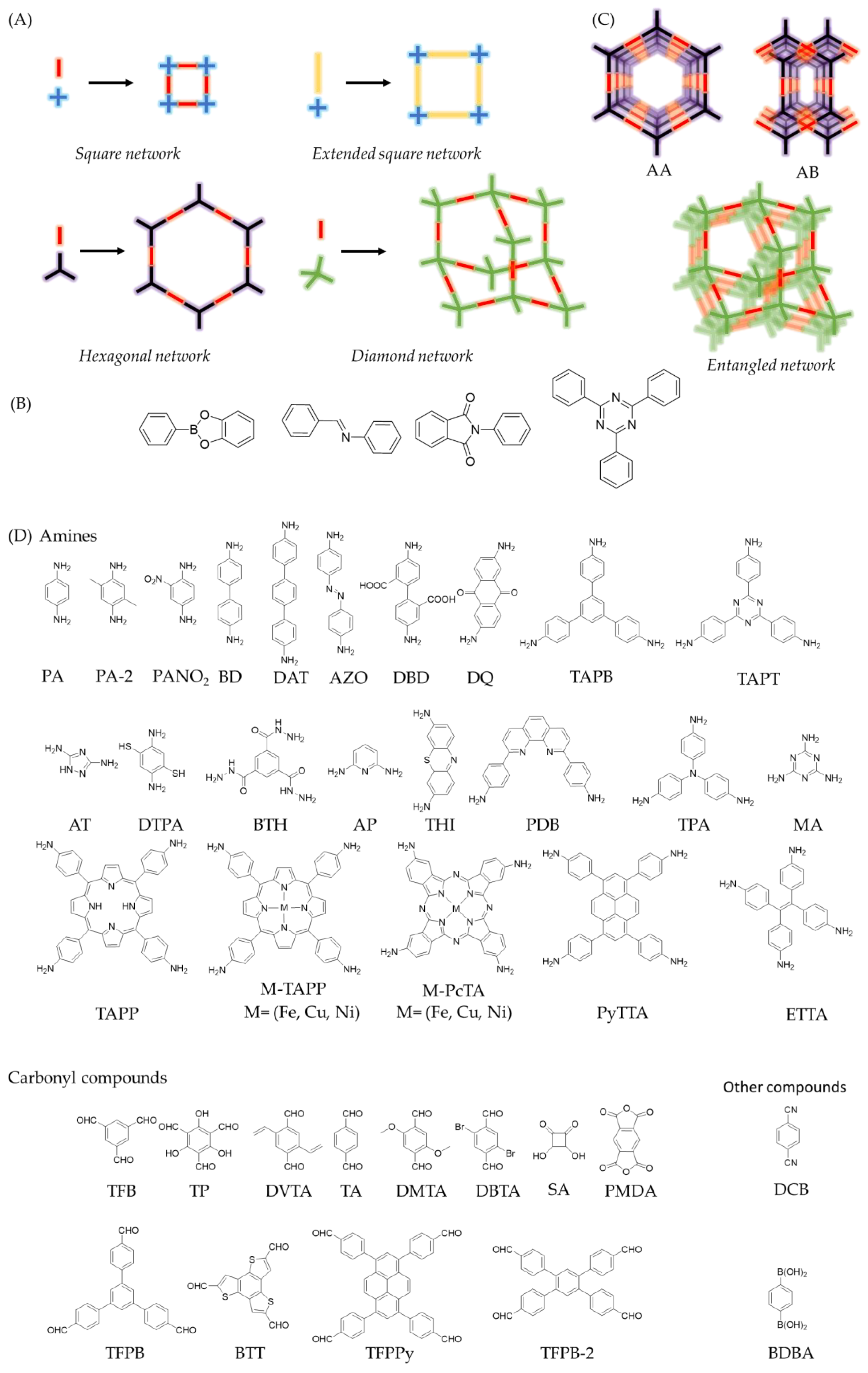
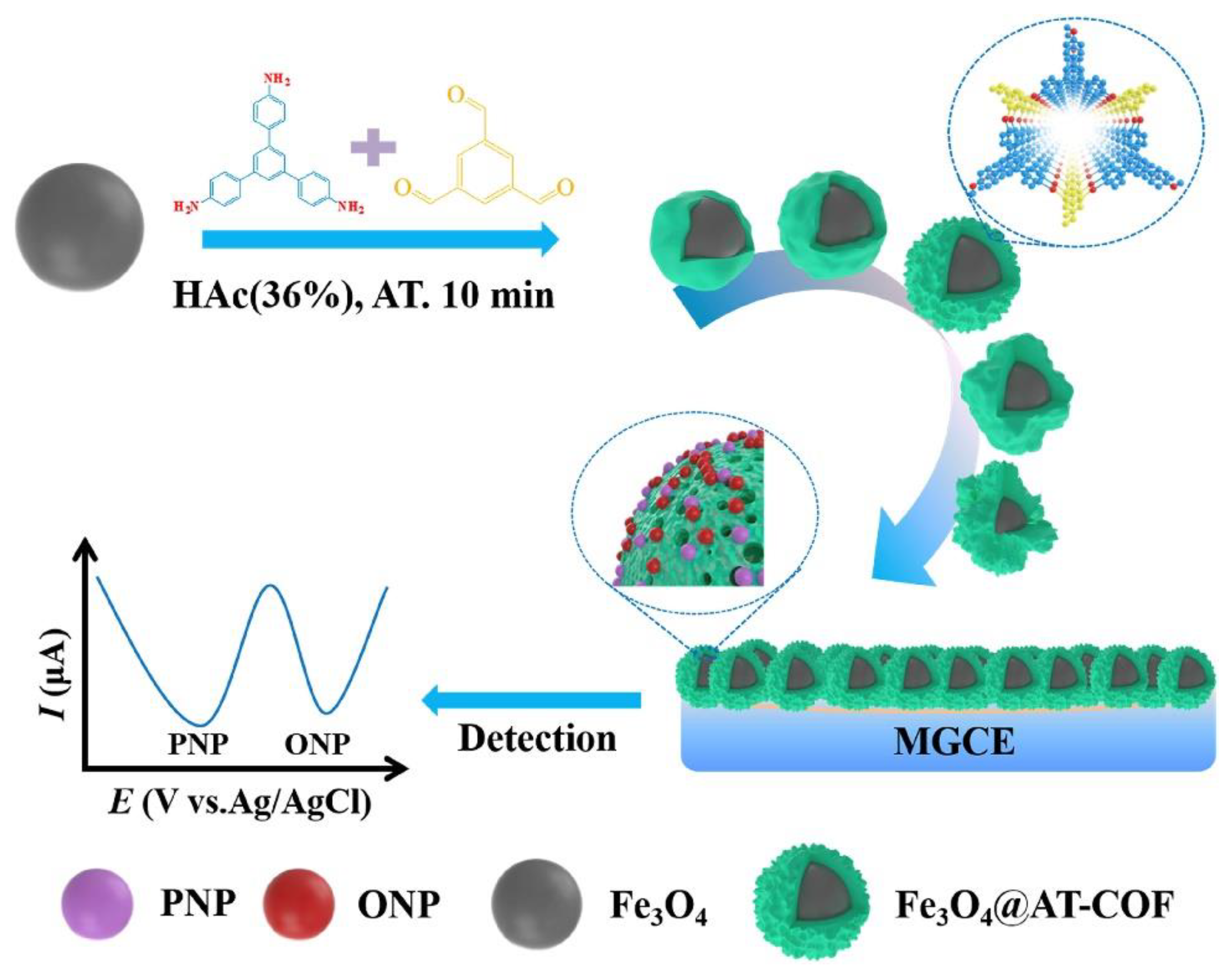
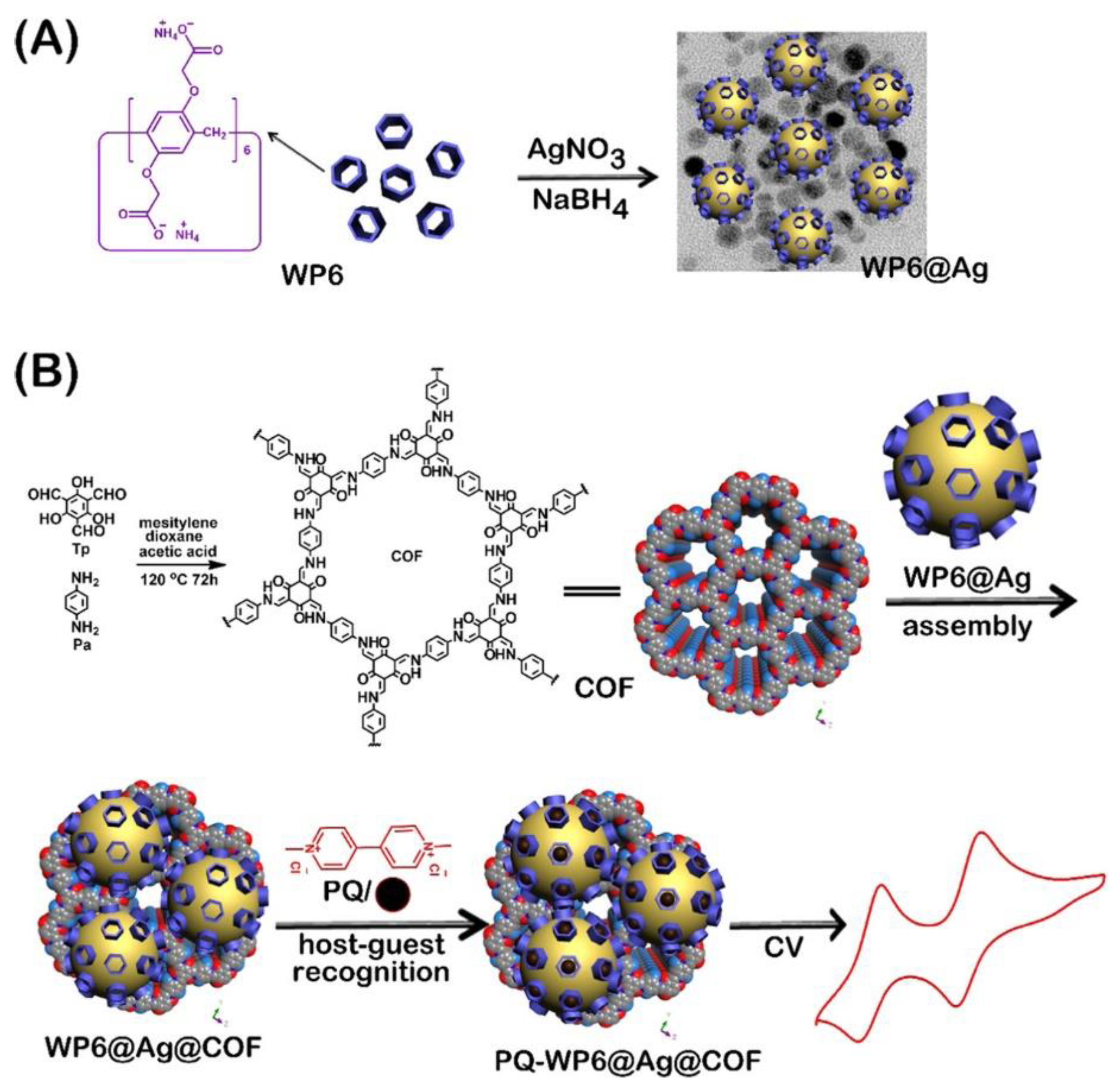
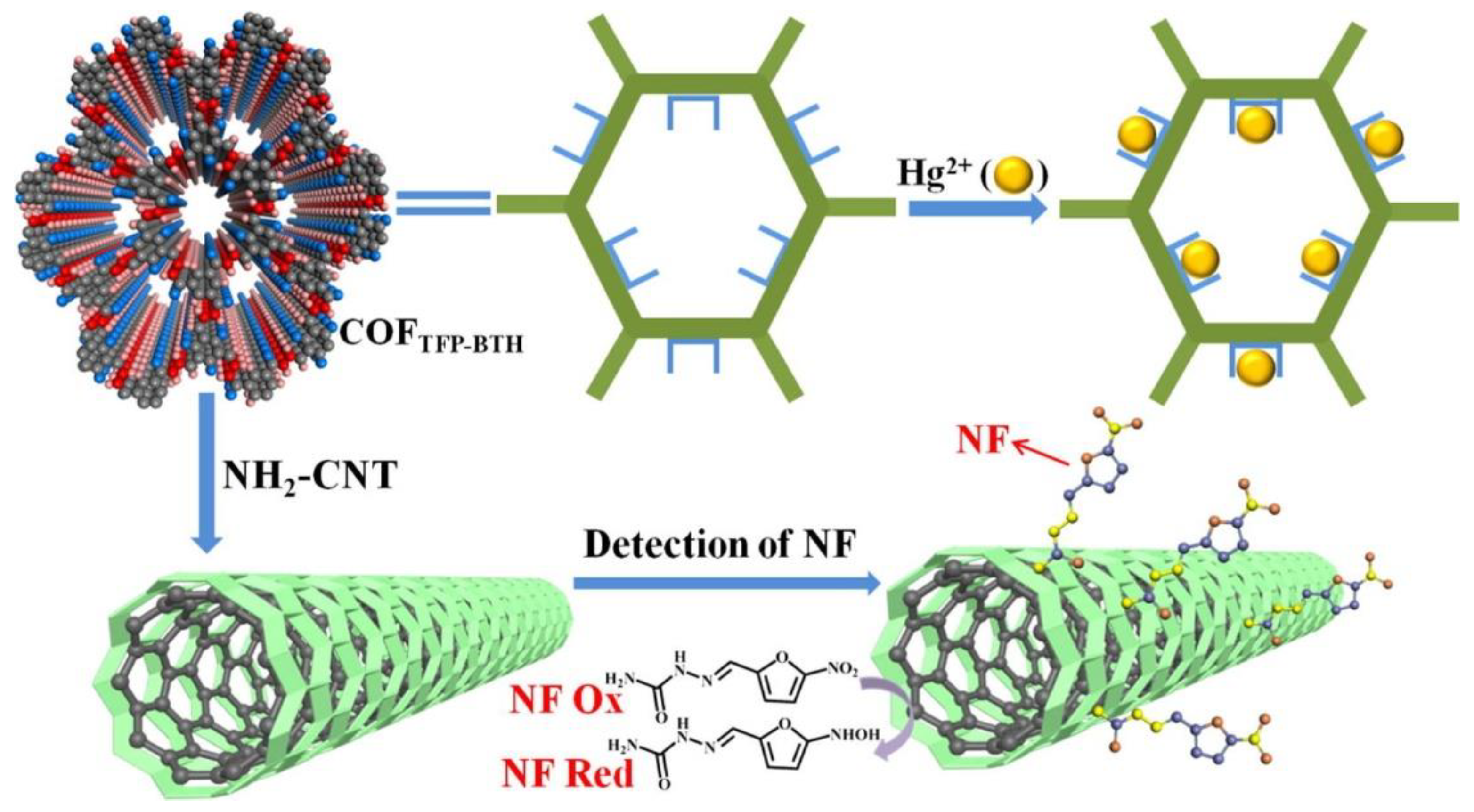
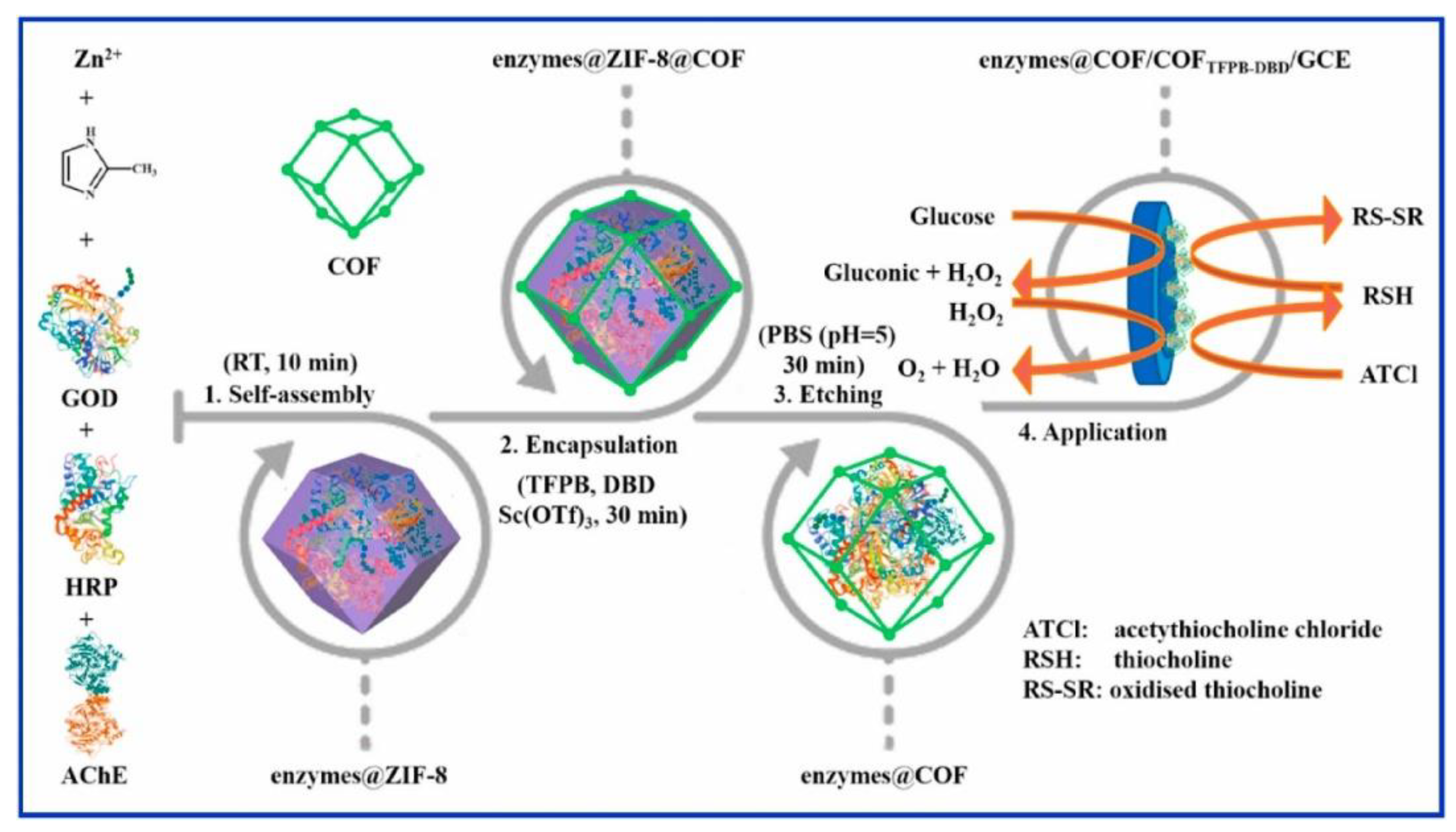
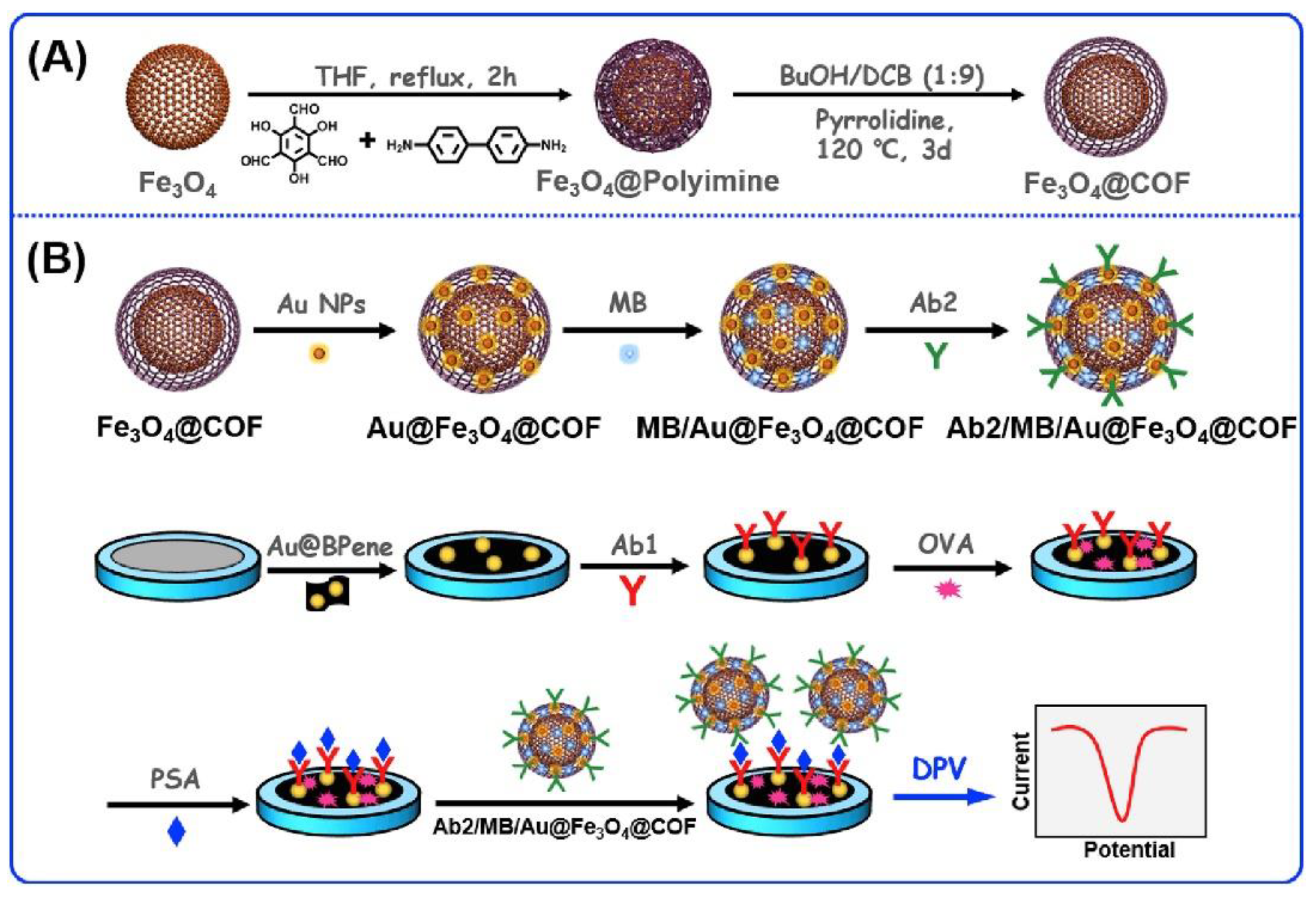
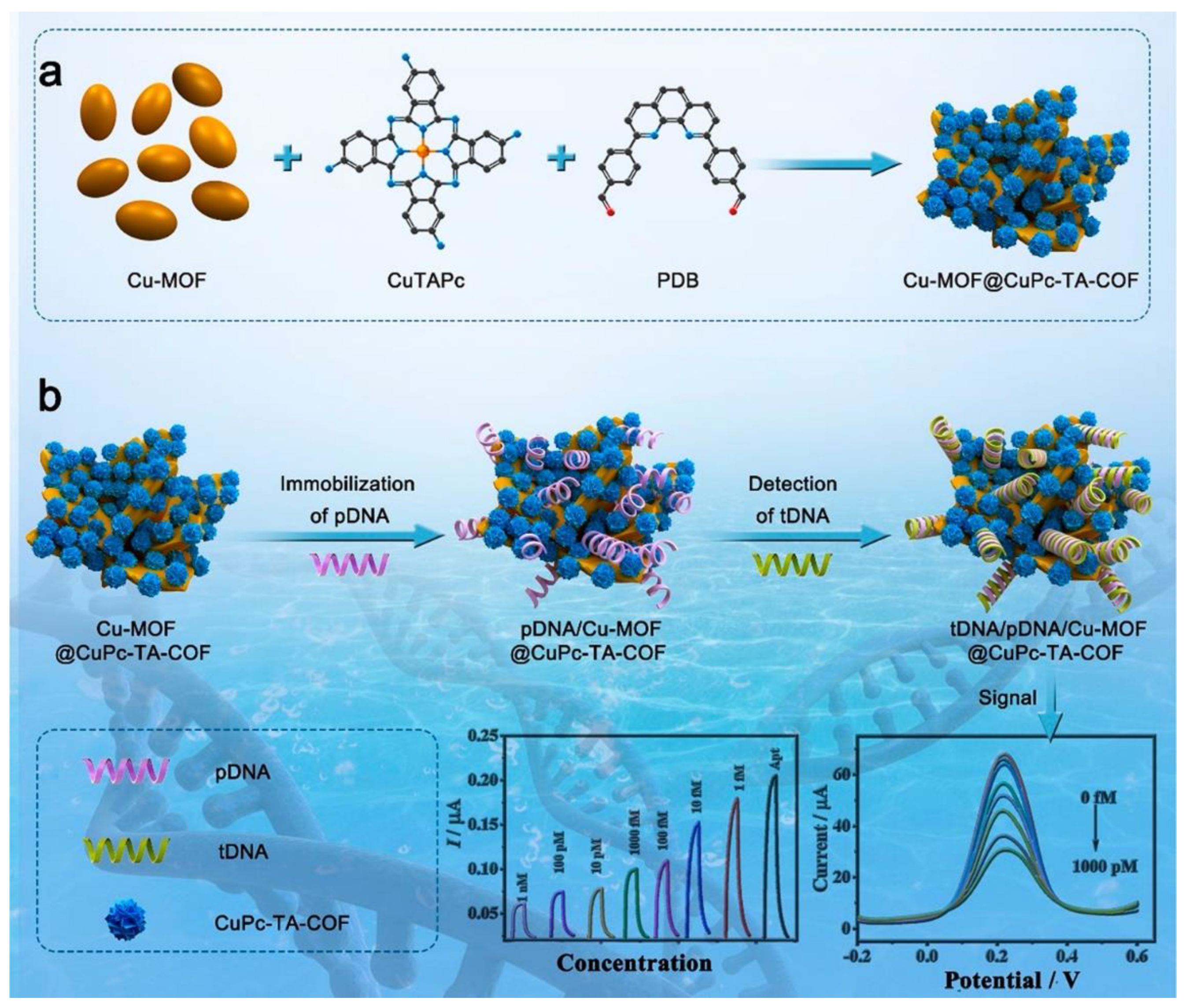
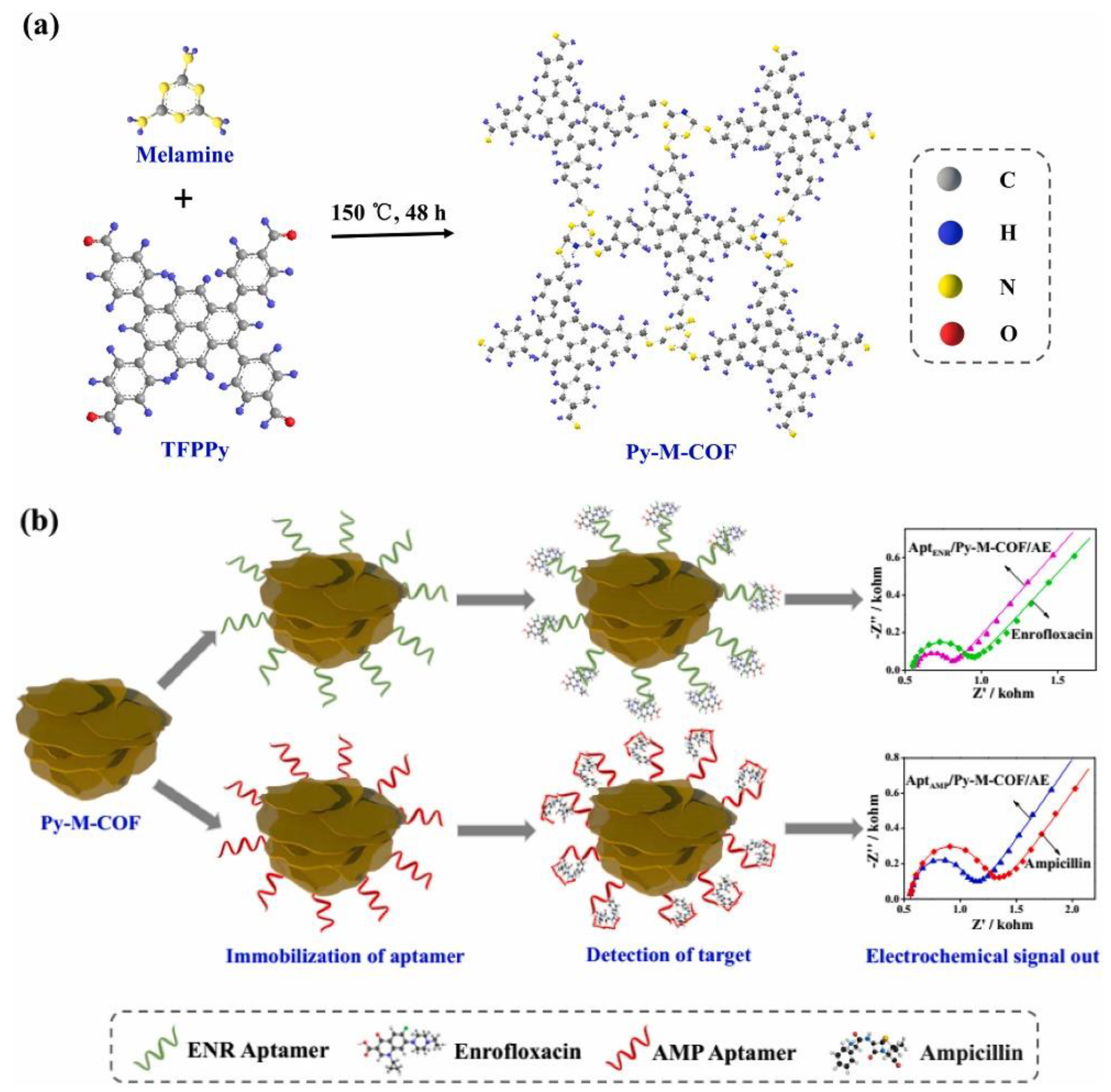
| COF | Modifier | Analyte | Sample | Electrode | LOD | Linear Range | Sensitivity | Ref. |
|---|---|---|---|---|---|---|---|---|
| DQTP-COF | β-ketoenamine | Bisphenol A, and S | Food packages | Graphite | 0.15 and 0.15 µM | 0.5–30 and 0.5–30 µM | 0.239 and 0.150 µA/µM | [80] |
| TPA-COF | Composite Carbon Black | Dopamine | Medical injections | Glassy Carbon | 0.17 µM | 20–1000 µM | 0.023 µA/µM | [65] |
| TAPB-DMTP-COF@PANI | polyanyline | Acetaminophen | Tablets, human blood, serum and urine | Glassy Carbon | 0.032 µM | 0.10–500 µM | 0.1229 µA/µM | [84] |
| Fe3O4@AT-COF | Fe3O4 | p-nitrophenol and o-nitrophenol | Lake and tap water | Magnetic beads | 0.2278 and 0.5925 μM | 10–3000 and 10–3000 µM | 0.7588 and 0.7799 µA/µM | [85] |
| FeTAPP-TA-COF | Composite graphene aerogel | NO | Complex biological system | Glassy carbon | 0.030 μM | 0.18–400 μM | 8.8 μA/μM·cm2 | [86] |
| MA-TP-COF | β-Ketoamine | Cd2+, Cu2+, Pb2+, Hg2+ and Zn2+ | Drinking water | Glassy Carbon | 0.922, 0.450, 0.309, 0.208 and 0.526 nM | - | 17.8, 36.6, 53.2, 79.1 and 31.3 μA/μM cm2 | [106] |
| DTPA-TFB-COF | kenaf stem-derived macroporous carbon | Cd2+, Pb2+, Cu2+ and Hg2+ | Soil and sewage | 12.3, 11.8, 18.6 and 21.4 nM | 0.0369–18.0, 0.0356–19.0, 0.0536–19.0, and 0.0503–18.0 µM | 1337.4, 1389.0, 886.2 and 770.0 μA/μM cm2 | [108] | |
| GOD/DMFc/PA-TFB-COF/CFMEs | DMFc and GOD | Glucose | Rats’ brains | Carbon fibre microelectrode | 0.36 µM | 1.08 μM to 8.5 mM | 46.55 mV/mM cm2 | [111] |
| enzyme@ZIF-8@COF | GOD, HRP, AChE | Glucose, H2O2 and malathion | Glassy Carbon | 0.85 μM, 2.81 nM, 3.0 × 10−13 g/L | 2.83 μM–8.0 mM, 9.53 nM–7.0 μM, 10−12 g/L–10−8 g/L | - | [75] | |
| COFs-AuNPs | AuNPs, Capture antiKIM-1 | KIM-1 | Plasma samples | Glassy Carbon | 2.00 fg/mL | 0.01–50.00 pg/mL | 1.8981 µA·mL/pg | [113] |
| AuPt@MnO2@COF | AuNPs, PSA affinity peptide | PSA | Human serum | 16.7 fg/mL | 0.00005–10 ng/mL | 2.237 µA/log (ng/mL) | [115] | |
| TP-PANO2-COF | AuNPs, CYFRA21-1 antibodies | CYFRA21-1 | Human serum | 0.1 pg/mL | 0.5–1.0 × 104 pg/mL | 6.3 µA/log (pg/mL) | [116] | |
| Cu-MOF@Cu-PcTA-COF | Cu-MOF, HIV-1 DNA probe strands | HIV-1 DNA | Human serum | Glassy carbon | 0.07 fM | 1 fM to 1 nM | - | [119] |
| Acronyms | ||||||||
| 1,3,5-triformylphloroglucinol (TP) and 2,6-diaminoanthraquinone (DQ) | ||||||||
| TPA-COF triphenylamine-based covalent-organic framework | ||||||||
| TAPB, 1,3,5-tris(4-aminophenyl)benzene; DMTA, 2,5-dimethoxyterephaldehyde | ||||||||
| 1,3,5-tris(4-aminophenyl) benzene (TAPB) and 1,3,5-benzenetricarboxaldehyde (TFB) | ||||||||
| 5,10,15,20-tetrakis [(4-aminophenyl) porphinato]-iron (Fe-TAPP) and terephthalaldehyde (TA) | ||||||||
| 2,4,6-triformylphloroglucinol and melamine (MA-TP-COF) | ||||||||
| 1,4-benzenedithiol-2,5-diamino-hydrochloride (DTPA) and 1,3,5-triformylbenzene (TFB) | ||||||||
| 1,3,5-Triformylbenzene (TFB) and 1,4-diaminobenzene (PA) | ||||||||
| 1,3,5-tris(p-formylphenyl) benzene (TFPB) and 4,4′-diaminobiphenyl-2,2′-dicarboxylic acid (DBD) in the presence of enzyme@ZIF-8 | ||||||||
| Triformylphloroglucinol and 2-nitrobenzene-1,4-diamine (PANO2) | ||||||||
| Copper-phthalocyaninetetra-amine (Cu-PcTA) and 2,9-bis[p-(formyl)phenyl]-1,10-phenanthroline (PDB) | ||||||||
Publisher’s Note: MDPI stays neutral with regard to jurisdictional claims in published maps and institutional affiliations. |
© 2022 by the authors. Licensee MDPI, Basel, Switzerland. This article is an open access article distributed under the terms and conditions of the Creative Commons Attribution (CC BY) license (https://creativecommons.org/licenses/by/4.0/).
Share and Cite
Martínez-Periñán, E.; Martínez-Fernández, M.; Segura, J.L.; Lorenzo, E. Electrochemical (Bio)Sensors Based on Covalent Organic Frameworks (COFs). Sensors 2022, 22, 4758. https://doi.org/10.3390/s22134758
Martínez-Periñán E, Martínez-Fernández M, Segura JL, Lorenzo E. Electrochemical (Bio)Sensors Based on Covalent Organic Frameworks (COFs). Sensors. 2022; 22(13):4758. https://doi.org/10.3390/s22134758
Chicago/Turabian StyleMartínez-Periñán, Emiliano, Marcos Martínez-Fernández, José L. Segura, and Encarnación Lorenzo. 2022. "Electrochemical (Bio)Sensors Based on Covalent Organic Frameworks (COFs)" Sensors 22, no. 13: 4758. https://doi.org/10.3390/s22134758
APA StyleMartínez-Periñán, E., Martínez-Fernández, M., Segura, J. L., & Lorenzo, E. (2022). Electrochemical (Bio)Sensors Based on Covalent Organic Frameworks (COFs). Sensors, 22(13), 4758. https://doi.org/10.3390/s22134758








